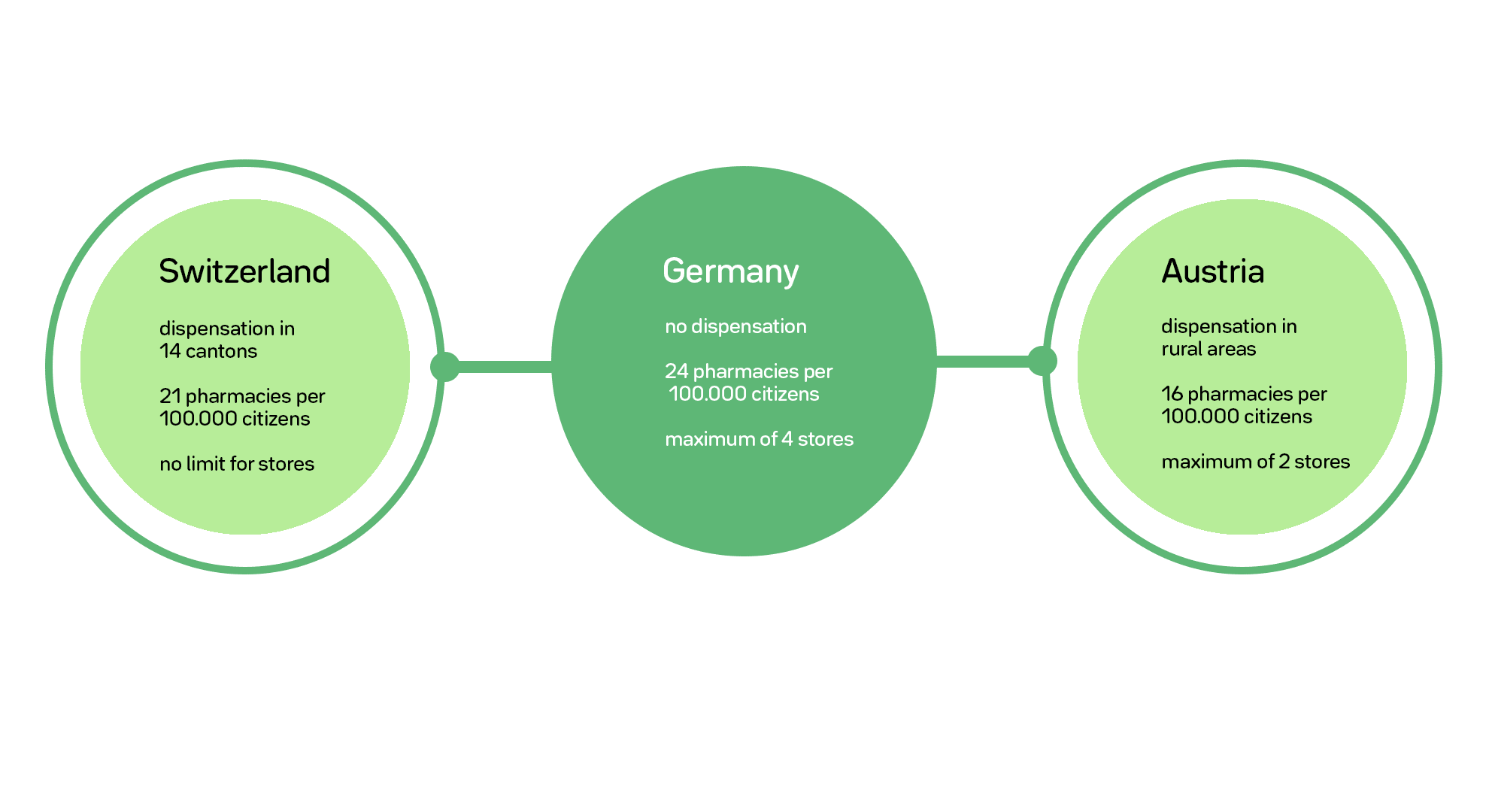Pharmacies in Switzerland and Austria are very similar to German drugstores. But still, there are crucial differences between the multi- and external ownership of pharmacies in the DACH region.
Germany holds a law about the prohibition of external ownership for pharmacies. Only autonomous pharmacists can run pharmacies. Corporations are not allowed to economize pharmacies with multiple stores. This is done to protect consumers. Pharmacists risk their approbation (governmental admission) if they set economic interests before the welfare of their customers.
The prohibition of multi ownership for pharmacies regulates that every pharmacist can only hold three branches beside his main store. Also, the branches must be set in local proximity to the main store.
Medication on demand in Austria
In neighboring Austria, this is regulated differently. Investors can buy holdings from pharmacies. The pharmacist, though, must own more than 50 percent of the assets to count as the operator of the pharmacy.
The DACH country has a demand-orientated medication system. If a pharmacist wants to open a new pharmacy, it must be a gap of 500 meters between the two stores. Besides that, every pharmacy needs to sustain 5.500 people in a radius of 4 kilometers. If that is not the case, doctors have the right to dispense drugs. They can run a pharmacy store in their office and sell medicines directly to the patient. That is only the case if there is no other pharmacy in a radius of 6 kilometers. Especially in rural areas that is a standard method.
Austrian mail order prohibition
The mail-order business with prescription drugs (Rx drugs) is strictly prohibited in Austria. Until 2015 the mail order of over-the-counter drugs (OTC drugs) was also illegal. Despite the official permission to sell OTC drugs, pharmacists in Austria are not interested in selling drugs via mail order. Only 24 out of 1.340 pharmacies are sending drugs to their customers.
Pharmacists can only run one more branch besides their main store. So, Austria, with 16 pharmacies per 100.000 citizens, is located far beneath the European average of 31. Germany currently lies above both other DACH countries with 24.

Swiss corporations are prevailing
Switzerland, with 21 pharmacies per 100.000 citizens, is located beneath the European average, too. However, the amount of swiss pharmacies is rising. Differently, compared to Germany and Austria, pharmacies in Switzerland often belong to groups (57,4 percent) or corporations (28,9 percent). 13.7 percent of swiss pharmacies were standalone in 2017.
The groups are merging out of pharmacies to get better conditions from the wholesalers. Also they can advertise their products and stores together even though the pharmacy by itself belongs to different pharmacists.
Discounter pharmacies in the alpine-state
There is no prohibition of external or multi ownership for pharmacies in Switzerland. Investors can buy an infinite number of pharmacies, which is very similar to the US.
Sunstore, for example, is a kind of discounter pharmacy. The company is not part of the Swiss pharmacy association and is regarded as controversial in terms of qualitative and moral standards. Sunstore owns more than 100 stores and is similar to German “Drogeriemärkte.” The biggest company is called Amavita, with 155 stores out of the 1800 pharmacies in the DACH country. Both companies belong to the Galenica Group, which is the largest network of pharmacies.
Strict regulations in Switzerland
Mail order with drugs is regulated. Salespeople can only send drugs with a prescribed recipe from a doctor. This applies for OTC and Rx drugs, although the Swiss corporation Zur Rose is the parent company of DocMorris, the largest mail-order company for medications in Germany.
The contribution of Rx drugs in Switzerland is not consistently regulated. In 14 cantons doctors are allowed to use the so-called “Selbstdispensation” to sell medicines directly to the patient as the Austrian doctors do. Nine cantons banned the dispensation altogether, like Germany; two more cantons hold a mixed form.
In some cantons, the dispensation is so widespread that pharmacies can not compete with doctors. In those areas, 85 percent of drugs are sold directly by doctors. Cantons without the dispensation right are selling 96 percent of the medicines in pharmacies.
